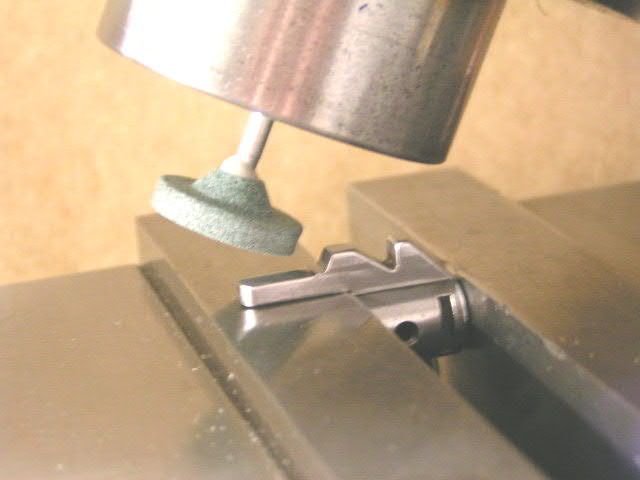Trigger Timing Modification Remington - Update
I have known for awhile that my 40x centerfire is much harder to close than my Vipers. I just assumed that it was due to bolt slop, and possibly some unintended consequence of the Savage bolt head conversion.
Yesterday while messing about with my rebated rim project I noticed that when closing the bolt the Vipers allow the cocking piece to move forward quite a bit before the trigger takes control of the cocking piece. The Vipers have about .200" to .210" of firing pin fall.
I then checked my 40x and the trigger takes control of the cocking piece in the first degree or 2 of bolt closing. This means that the cocking piece ends up sticking farther out of the back of the bolt when the bolt is closed versus where the cocking piece is in the bolt open condition. It measured about .070" out the back of the shroud whereas in the bolt open condition the cocking piece is basically even with the back of the shroud. The Remington had about .280" of firing pin fall.
I decided to try and move the cocking piece engagement surface back about .070 so the firing pin fall would match the Vipers and hopefully this would make a dramatic difference in the bolt closing resisitance.
The cocking piece is too hard to cut with a HSS end mill so I had to come up with a way of accurately grinding it and the pic below shows what I came up with. It worked great. I was able to remove just the amount of metal I wanted and the closing force is much better.
I removed the metal in .005" increments with multiple slow passes on each cut. Then radius all the edges with a ceramic disc and polish the new engagement surface and I was done.
If the gun misfires at the match Saturday I will be screwed !!!

I have known for awhile that my 40x centerfire is much harder to close than my Vipers. I just assumed that it was due to bolt slop, and possibly some unintended consequence of the Savage bolt head conversion.
Yesterday while messing about with my rebated rim project I noticed that when closing the bolt the Vipers allow the cocking piece to move forward quite a bit before the trigger takes control of the cocking piece. The Vipers have about .200" to .210" of firing pin fall.
I then checked my 40x and the trigger takes control of the cocking piece in the first degree or 2 of bolt closing. This means that the cocking piece ends up sticking farther out of the back of the bolt when the bolt is closed versus where the cocking piece is in the bolt open condition. It measured about .070" out the back of the shroud whereas in the bolt open condition the cocking piece is basically even with the back of the shroud. The Remington had about .280" of firing pin fall.
I decided to try and move the cocking piece engagement surface back about .070 so the firing pin fall would match the Vipers and hopefully this would make a dramatic difference in the bolt closing resisitance.
The cocking piece is too hard to cut with a HSS end mill so I had to come up with a way of accurately grinding it and the pic below shows what I came up with. It worked great. I was able to remove just the amount of metal I wanted and the closing force is much better.
I removed the metal in .005" increments with multiple slow passes on each cut. Then radius all the edges with a ceramic disc and polish the new engagement surface and I was done.
If the gun misfires at the match Saturday I will be screwed !!!

Last edited:


